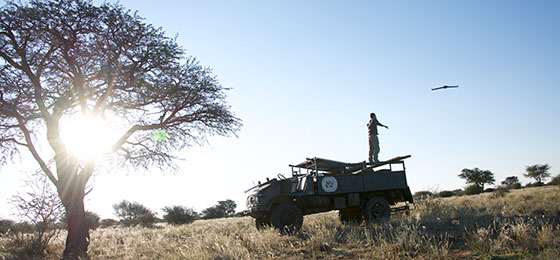

Counting animals in wildlife reserves with the help of drones: the SNSF-funded research team tests their new technique on the ground in Namibia.
Photo: Schweizerischer Nationalfonds SNF
A new technique developed by Swiss researchers enables fast and accurate counting of gnu, oryx and other large mammals living in wildlife reserves. Drones are used to remotely photograph wilderness areas, and the images are then analysed using object recognition software and verified by humans. The work is reported in a paper published in the journal Remote Sensing of Environment. (*)
The challenge is daunting: some African national parks extend over areas that are half the size of Switzerland, says Devis Tuia, an SNSF Professor now at the University of Wageningen (Netherlands) and a member of the team behind the Savmap project, launched in 2014 at EPFL. “Automating part of the animal counting makes it easier to collect more accurate and up-to-date information.”
No animal left uncounted
The drones make it possible to cover vast areas economically. But it's more complicated than simply sending them up to photograph the terrain: more than 150 images are taken per square kilometre. At first glance, it's hard to tell the animals from other features of the landscape such as shrubs and rocks.
To decipher this mass of raw visual data, the researchers used a kind of artificial intelligence (AI) known as “deep learning”. Conceived by PhD candidate Benjamin Kellenberger, the algorithm enables researchers to immediately eliminate most of the images that contain no wildlife. In the other images, the algorithm highlights the patterns most likely to be animals.
This initial phase of elimination and sorting is the longest and most painstaking, says Tuia. “For the AI system to do this effectively, it can't miss a single animal. So it has to be have a fairly large tolerance, even if that means generating more false positives, such as bushes wrongly identified as animals, which then have to be manually eliminated.”
The team started by preparing the data needed to train the AI system to recognise features of interest. During an international crowdsourcing campaign launched by EPFL, some 200 volunteers tracked animals in thousands of aerial photographs of the savannah taken by researchers at the Kuzikus wildlife reserve in Namibia.
These images were then analysed by the AI system, which had been trained by scoring based on different types of errors: the AI system is given one penalty point for mistaking a bush for an animal, whereas the penalty for missing an animal completely is 80 points. As a result, the software learns to distinguish wildlife from inanimate features, but especially not to miss any animals. Once the collection of images has been whittled down by the AI system, a human takes over the final sorting, made easier by coloured frames automatically placed around questionable features.
100 square kilometres per week
This semi-automated technique was developed in collaboration with biologists at the Kuzikus wildlife reserve in Namibia. Since 2014, the researchers have periodically flown over the reserve using drones designed and optimised by SenseFly, a Swiss company, and equipped with compact, standard cameras. “In the beginning we were rather sceptical,” says Friedrich Reinhard, director of the reserve. “The drones produce so many images that I thought it would be difficult to use.”
But, thanks to the sorting performed by the AI system, just one person can carry out a full count of the Namibian reserve – an area of around 100 square kilometres – in about a week. In contrast, conventional methods involve entire teams taken aboard a helicopter. These methods are both less accurate and so expensive that they are rarely used – once a year at most in Kuzikus.
The Swiss researchers are continuing their work with the Namibian reserve. EPFL students travel there regularly. The Kenyan authorities have also expressed interest, as has the Veluwe National Park in the Netherlands. Recently appointed professor at the University of Wageningen (Netherlands), Devis Tuia still works closely with the University of Zurich (where he was SNSF Professor) and EPFL, which coordinates the Savmap project.
Promoting young researchers
The SNSF has launched a new funding scheme to support researchers aiming to obtain a professorship. SNSF Eccellenza Grants allow tenure-track assistant professors to form a new research team and lead an ambitious scientific project. SNSF Eccellenza Professorial Fellowships cover the salaries of assistant professors as well as their project costs. The new scheme replaces the SNSF professorship grant, which has supported 691 researchers since its launch in 2000 – with great success: around 80% of grantees went on to obtain a professorship at a higher education institution in Switzerland or abroad.
Eccellenza: http://www.snf.ch/fr/encouragement/carrieres/eccellenza
Prof. Devis Tuia
Laboratory of Geo-information Science and Remote Sensing
Wageningen University & Research
Droevendaalsesteeg 3
6708 PB Wageningen
The Netherlands
Tel: +31 317 489 403
E-mail: devis.tuia@wur.nl
(*) Detecting Mammals in UAV Images: Best Practices to address a substantially Imbalanced Dataset with Deep Learning, Remote Sensing of Environment (2018).
DOI: 10.1016/j.rse.2018.06.028
https://authors.elsevier.com/a/1XKYp7qzSjUbR
http://www.snf.ch/press-release-drones-survey-african-wildlife 'Download images for editorial use and further information'















